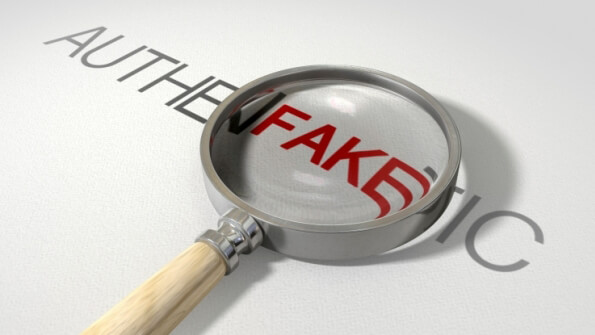On Counterfeit Valves and Fittings
Counterfeit Valves: They Fake It Till They Break It
 From iPhones to watches to shoes and apparel, it seems that for every legitimate product on the market, there are twice as many cheaply made counterfeits. And believe it or not, industrial valve manufacturers have not remained immune to this problem. The market is saturated with counterfeit valves and fittings, but it can be difficult to know how many are out there. Many simply go undetected, only recognized for what they are once they fail. And even when counterfeit valves or fittings do fail, under-reporting of these incidents seems to be somewhat prevalent. While most end users whose valves have failed were probably unaware the products they used were counterfeits, others may forego reporting for risk of damaging their reputation or being seen as negligent.
From iPhones to watches to shoes and apparel, it seems that for every legitimate product on the market, there are twice as many cheaply made counterfeits. And believe it or not, industrial valve manufacturers have not remained immune to this problem. The market is saturated with counterfeit valves and fittings, but it can be difficult to know how many are out there. Many simply go undetected, only recognized for what they are once they fail. And even when counterfeit valves or fittings do fail, under-reporting of these incidents seems to be somewhat prevalent. While most end users whose valves have failed were probably unaware the products they used were counterfeits, others may forego reporting for risk of damaging their reputation or being seen as negligent.
There Are Counterfeits, and Then There Are…Counterfeits
We should note that when we discuss counterfeit valves, there are two categories they generally fall under. Manufactured fakes are what a consumer typically thinks of as a counterfeit. These are analogous to those Louis Vuitton handbags going for 1/10th their market value.
The other type of counterfeit valve is one that has been refurbished by a dubious supplier looking to make an easy buck. If a manufacturer or legitimate supplier was in the midst of overhauling or renovating its plant, for instance, it might have sold off older valves as scrap. Regardless of the motives, problems can arise when those valves are then processed to make them once again operational. Too frequently, forged manufacturer tags are affixed to the rebuilt valves in an effort mislead end users. Unless a valve has been refurbished, retested and recertified by an OEM, it’s probably worth considering this type of counterfeit just as dangerous—and in some cases more dangerous—than a manufactured counterfeit.
Counterfeit valves and fittings can be so challenging to spot that they’ve been discovered in chemical processing plants and even nuclear power plants. That’s a scary thought, and, thankfully, those counterfeits were found before they had a chance to fail. Others have been less lucky, though, like a paper mill that decided to cut costs by purchasing remanufactured valves from a third-party supplier. The supplier neglected to verify the valves’ wall thicknesses—something that should really be done by an OEM, who knows where to measure for critical dimensions—resulting in a catastrophic failure after the side of the valve blew out.
Shut off the Flow of Counterfeits
So, how can you avoid purchasing counterfeit valves and fittings? Know your suppliers well, or purchase directly from the established OEMs. When dealing with suppliers, consider integrating into your contract language that holds them responsible for counterfeits that enter their supply chain and make into your application. For instance, your supplier might receive a large order from another client, forcing them to seek out a new source they may be less familiar with.
Beyond that, it’s worth becoming familiar with how to spot counterfeits. Depending on the effort that has been made to hide the counterfeit’s true nature, this can be challenging. For the simpler counterfeits, follow a few of the suggestions below from the Department of Energy’s Health, Safety and Security Office of Corporate Safety Analysis. Below is a sampling taken from their “Suspect/Counterfeit Items Awareness Training” manual.
- Used component appearance, including signs of weld repairs, outer surface scratches, wrench marks on valve packing glands, nuts and bolts, different types of hand wheels on valves from the same manufacturer and certain parts looking newer than others
- Suspicious or inadequate packaging, including the use of foreign newspapers as packing material
- Components with no markings, or those missing important designations like pressure class ratings
- Components with too many markings (e.g. an excess of certification logos like “UL,” “FM,” “CGA” and “AGA” all appearing on one valve body is not normal; one or two logos plus “ANSI” or “ASME” is)
- Evidence of tampering, including ground off logo marks, ground off casting marks with stamped marks in their vicinity and overlapping stamps
- Old or worn nameplates, or nameplates that look newer than the components themselves
In Conclusion
As you can probably tell, the time that goes into detecting counterfeits probably negates any cost savings a supplier or end user might have otherwise been glad to find. Yes, counterfeit products are inexpensive. The irony is, their long-term—and even their short-term—cost is far greater than the price of a highly engineered, expertly crafted valve made to last.
Want to be sure you’re getting the real deal? Buy direct from the OEM, or require your supplier or contractor to do the same. Do CPV valves cost more than counterfeits? Of course. We engineer them to exacting standards. They’re made to last. Because ultimately, we’d rather explain the price of our valves to our customers once than apologize for their quality forever.
